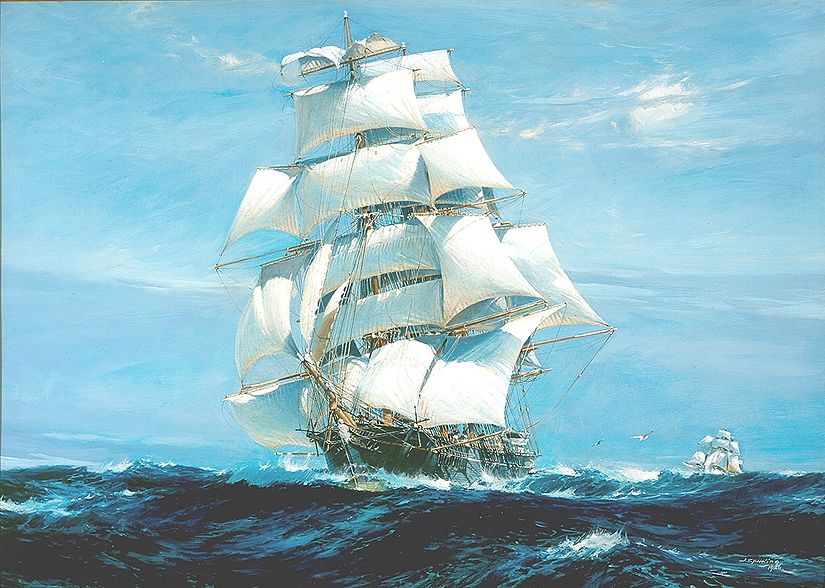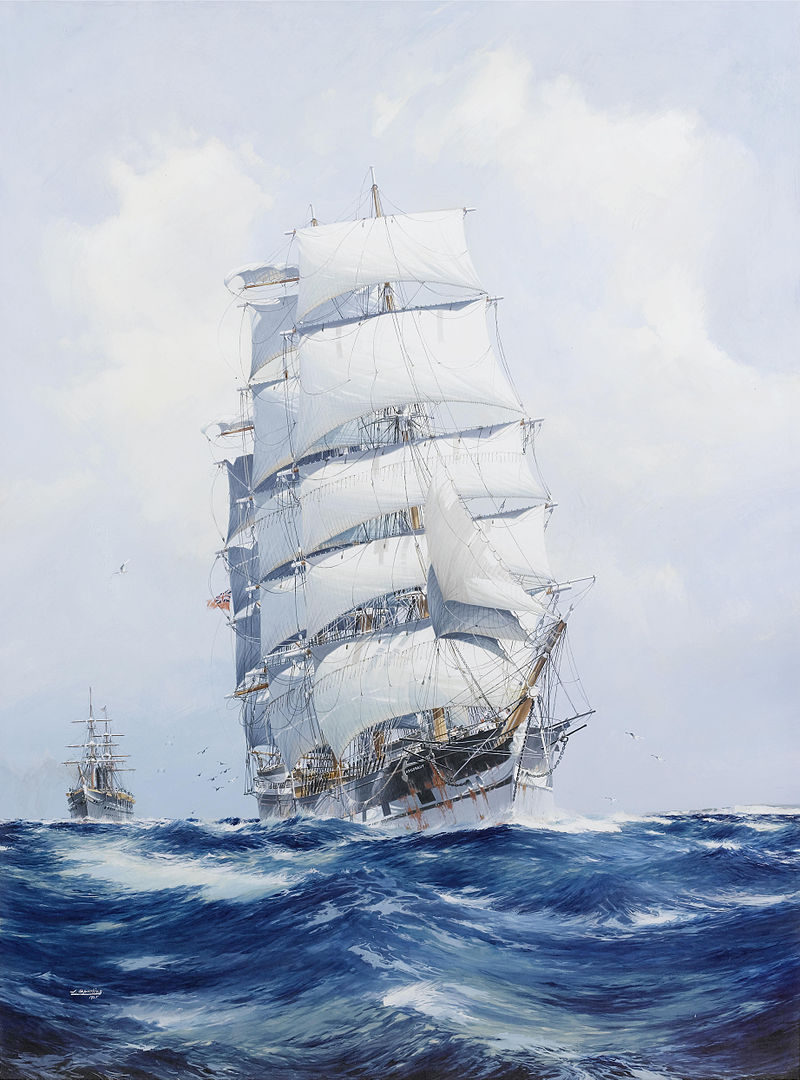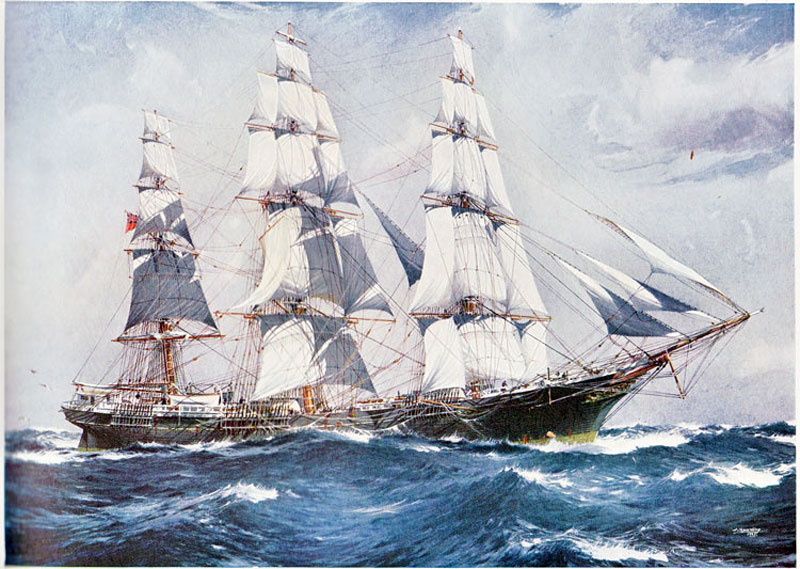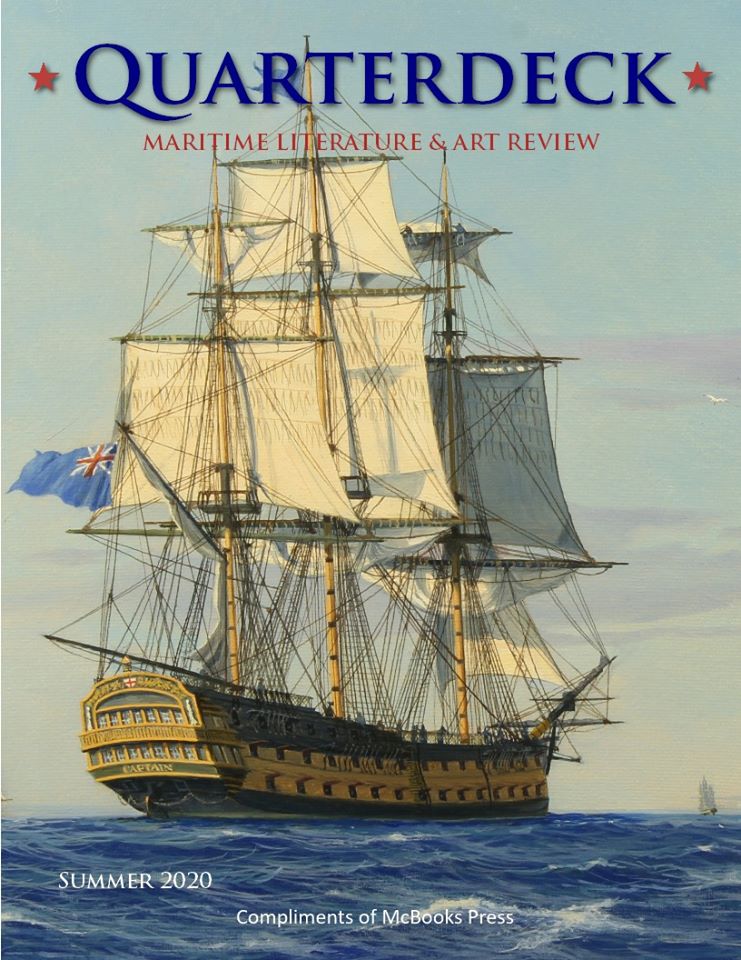Hell at Sea: Merchant Service in the mid-19th Century
It is impossible to see images of the great clippers and other large vessels under sail in the mid to late 19th Century, a time when hull design and the technologies and disciplines of managing sail reached their apogee, without being fired with admiration. The great “tea races” – in which vessel as competed to be first to the year’s new crop from China to London – were spectacular events, admired and followed by the general public. The most notable these was in 1866, when the clipper Taeping docked 28 minutes ahead of her closest rival, the Ariel, after a 99-day passage logged at 15,800 miles. They had left China on the same tide, followed a route around the Cape of Good Hope and docked on the same tide in Britain. There were other equally remarkable voyages – some being mentioned later in this article.

Ariel leading Taeping, painting by Jack Spurling (1870-1933)
The beauty of these ships, and the spectacular sight they made under full sail, easily blind one to the fact that many of them were floating hells, on which seamen, enlisted for each voyage only, were driven to the limits of human endurance. Unprotected by the rules and regulations applying in national navies, and enjoying the scantiest of legal protection, they were often at the mercy of captains whose characters and behaviours bordered on the psychopathic.
 Taeping and Ariel racing up the Channel, by Thomas G. Dutton (1820-1891)
Taeping and Ariel racing up the Channel, by Thomas G. Dutton (1820-1891)

Baron Walter Runciman
An interesting insight to such conditions comes from the memoirs of Baron Walter Runciman (1847 –1937), who was a classic case of a poor boy of high initiative “making good”. Born in Dunbar, Scotland, son of a schooner captain who later became a coastguard in Northumberland, he ran away to sea at the age of twelve. A ship’s master himself by 21, he founded a shipping line and in due course became a major force in the British mercantile industry up to his death. On the way he was elected also as a Liberal Member of Parliament and was subsequently raised to the House of Lords. He prefaced him memoir “Windjammers and Sea Tramps”, published in 1905, with the justifiably proud statement that “I went in at the hawse-hole and came out at the cabin window.”
Even in the days of his prosperity, Runciman appears to have been still so marked by the horrors of his early service that he entitled one of his chapters, “Brutality at Sea”. It’s worth quoting from it to get a feel for the world he entered. He described many a captain as a man “who would pace the poop or quarter-deck of his vessel with the air of a monarch. Sometimes a slight omission of deference to his monarchy would take place on the part of officers or crew. That was an infringement of dignity which had to be promptly reproved by stern disciplinary measures.”

Clipper Argonaut by Jack Spurling
An offending officer would get off relatively lightly by being “usually ordered to his berth for twenty-four hours—that is put off duty.” The seamen would fare worse, since often “offences were rigorously atoned for by their being what is called “worked up,” i.e., kept on duty during their watch below; or, what was more provoking still, they might be ordered to “sweat up” sails that they knew did not require touching. This idle aggravation was frequently carried out with the object of getting the men to revolt; they were then logged for refusing duty and their pay stopped at the end of the voyage. It was not an infrequent occurrence for grown men to be handcuffed for some minor offence that should never have been noticed.”
Runciman indicates that an element of deliberate sadism was often involved: “The sight of human suffering and degradation was an agreeable excitement to this class of officer or captain. If some of the villainy committed in the name of the law at sea were to be written, it would be a revolting revelation of wickedness, of unheard-of cruelty. Small cabin-boys who had not seen more than twelve summers were good sport for frosty-blooded scoundrels to rope’s-end or otherwise brutally use, because they failed to do their part in stowing a royal or in some other way showed indications of limited strength or lack of knowledge. The barbarous creed of the whole class was to lash their subjects to their duties.”
One suspects that one specific case mentioned might have referred to Runciman himself: “A little fellow, well known to myself, who had not reached his thirteenth year, had his eyes blacked and his little body scandalously maltreated because he had been made nervous by continuous bullying, and did not steer so well as he might have done had he been left alone. It is almost incredible, but it is true, some of these rascals would at times have men hung up by their thumbs in the mizzen rigging for having committed what would be considered nowadays a most trivial offence.”
 Voyage’s End: “Mist in the Port of London” by Charles John de Lacy (1860-1936)
Voyage’s End: “Mist in the Port of London” by Charles John de Lacy (1860-1936)
Runciman noted the “captains who claimed public attention for reasons that would not now be looked upon with favour were usually known by the opprobrious name of ‘Bully this’ or ‘Bully that.’” and that “it was generally the fearless way in which they carried sail, and their harsh, brutal treatment of their crews that fixed the epithet upon them. I am quite sure many of them were proud of it.” Runciman drew attention to “One gentleman, well known in his time by the name of Bully W——, (who) stood on the poop of the square-rigged ship Challenge, and shot a seaman who was at work on the main yardarm.” He identified this captain as having “once commanded a crack, square-rigged clipper called the Flying Cloud.”

Robert H. Waterman
The “Bully W – – “ to whom Runciman referred was the American Robert Waterman (1808 – 1884). His reputation as a hard driver was confirmed in 1849 when he brought the clipper Sea Witch – carrying more sail a than a “74” ship of the line – from Hong Kong to New York vis the Cape of Good Hope in 74 days. His longest distance covered in a single day was 308 miles. Two years later Waterman took command of the new clipper Challenge, being offered a bonus of $10,000 if he could get her from New York to San Francisco within 90 days. The treatment of his crew was such as to trigger a minor munity, in which the first mate was almost killed, followed by Waterman’s flogging of the mutineers – something that had been outlawed by the US Congress the previous year. Waterman also slashed the cook’s scalp with a carving knife and broke the arm of one of the mutineers with a club, then had him shackled the fractured limb. A later incident, involving the death of a seaman, led to him having no further commands.

Clipper James Baines by Jack Spurling (1870-1933)
Runciman mentions that Waterman was said “never to have voluntarily taken canvas in. He was one of those who used to lock tacks and sheets, so that if the officers were overcome by fear they could not shorten canvas.” Paradoxically “His fame spread until it was considered an honour to look upon him, much less to know him. He became the object of adoration, and perhaps his knowledge of this swelled his conceit.”
“But this man was only one among scores like him,” Runciman recalls.
It’s a fact worth remembering when we look on images of the great square-riggers in all their glory.
 The Spring 2020 edition of Quarterdeck Magazine, devoted to naval fiction of all eras, and which this time features, among much else, an article about Antoine Vanner, author of the Dawlish Chronicles series, is now available. Click on the cover image on the right to download.
The Spring 2020 edition of Quarterdeck Magazine, devoted to naval fiction of all eras, and which this time features, among much else, an article about Antoine Vanner, author of the Dawlish Chronicles series, is now available. Click on the cover image on the right to download.
The Dawlish Chronicles – now up to eight volumes, and counting …
Six free short-stories are available for download to your Kindle. Access them by registering for the Dawlish Chronicles mailing list – just click on the banner below. You’ll be kept updated on new books and will receive other free stories at intervals.


